Simple interest is the method of calculating or finding the interest rate on actual payment. It is calculated on the principal or original amount of a loan. This is the easiest way to measure the interest rate on the original payment. You can learn this different method through the below-covered topics.
This content covers:
- What is simple interest?
- How to Calculate Simple Interest in Excel?
- How to Calculate simple interest with present value?
- What is simple interest present value?
- How to Calculate simple interest with future value?
- What is simple interest future value?
- How to calculate Annual compound interest in Excel?
1. What is simple interest?
Simple interest is a type of interest that is calculated only on the principal amount, without considering any interest charged in previous periods. It is a fixed percentage of the principal amount that is charged or earned over a specific period. This is the easiest way to measure the specific payment interest. Here is the formula: Simple interest = Principle amount × Interest rate × Year
2. How to Calculate Simple Interest in Excel?
You can calculate the simple interest in Excel by following these steps with examples.
Steps 1: Create a data table with the information below.
Placed the information here.

Step 2: Add a column A7 and B7 to get the simple interest rate.
Added the column here.
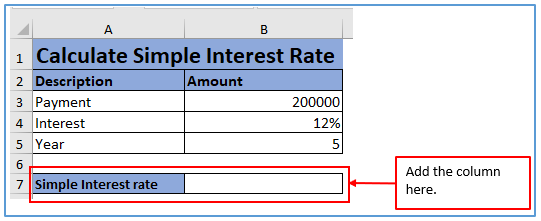
Step 3: Refer to the principal amount and enter an asterisk sign to multiply. After that, refer to the interest rate. Again enter an asterisk to multiply and refer to the year value. The formula will be for simple interest rate: =B3*B4*B5
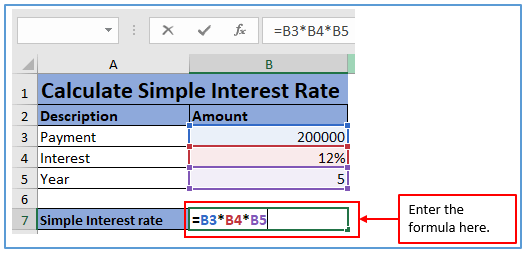
Step 4: In the end, hit enter to get the simple interest value.
Here is the result below.
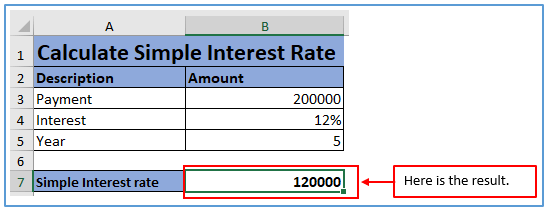
3. How to Calculate simple interest with present value?
To follow up those steps, you can calculate simple interest with present value in Excel. You have to know the present value formula: future value/(1+interest rate*year)
Here, Future Value(FV)= 1,00,000 Tk.
Interest rate = 4%
Year(n)= 5
Steps 1: Create a data table with the information above.
Entered the information here.

Step 2: Add a column A7 and B7 to get the simple interest rate with Present value.
Added the column here.
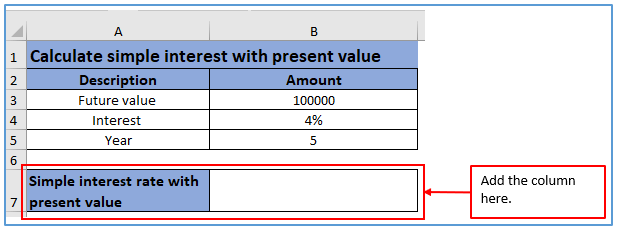
Step 3: Then, use the formula of present value: =B3/(1+B4*B5)
Applied the formula below.
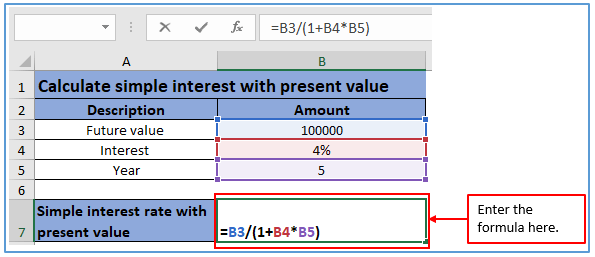
Step 4: Afte putting the formula Click the enter button on your keyboard and after that you will get the simple interest with present value like the below picture.
The result is shown below.
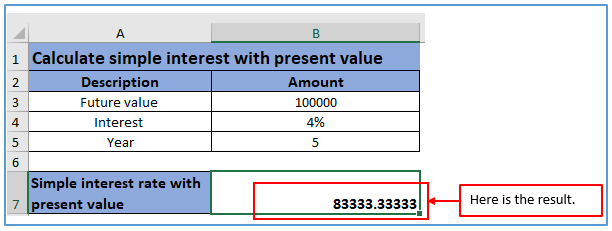
4. What is simple interest present value?
In a short way, the simple interest present value is the value where you can get the present value of future cash flows with a discount rate. Present value is the current value of a future sum of money or cash flows given a specified rate of return. It is calculated by using this formula: = future value/(1 + interest rate*year)
5. How to Calculate simple interest with future value?
To follow up those steps, you can calculate simple interest with future value in Excel. Here is an example:-
Steps 1: Make a data table.
Here, Present Value(PV)= 1,00,000 Tk, Interest rate = 5%, Year(n)= 5
Entered the above data here into the table.

Step 2: Add the column A7 and B7 to get the simple interest rate with Future value.
Added the column here.
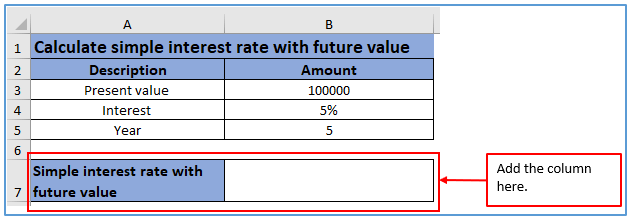
Step 3: You must know the future value formula: future value=present value*(1+interest rate*year). Use the formula of future value according to the column: =B3*(1+B4*B5)
Applied the formula below.
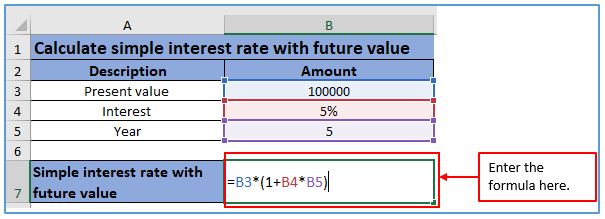
Step 4: While completing enter the formula then press Enter and then you will get the value of the future amount.
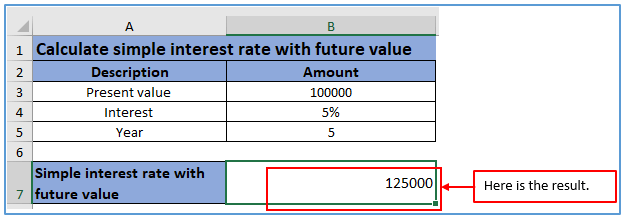
6. What is simple interest future value?
Simple interest future value is the amount of money that will be accumulated at a future date, assuming a simple interest rate and a specific investment amount and time period. It is calculated using the following formula: F = P * (1 + rt)
Here, F= future value, P= present value, R= interest rate, T= year/time
7. How to calculate Annual compound interest in Excel?.
The formula for calculating annual compound interest is: =Principle amount*(1+r/m)^n*m
where:
- r is the annual interest rate (as a decimal)
- m is the number of compounding periods per year
- n is the number of years
Example: If For example, if you have a present value of $1000, an annual interest rate of 5%, and a compounding period of 12 months.
Placed the data into the table.

Step 2: Add the column A7 and B7 to get the annual compound interest rate.
Added the column here.

Step 3: Now, write down the compounding formula: =B3*((1+B4/B5)^(1*B5))
Entered the formula here.
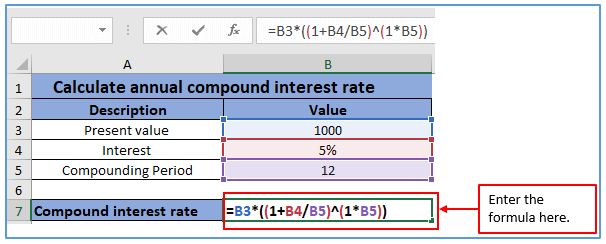
Step 4: After writing the formula click the enter button, then you will get the compounding value.
The result is outlined below.

You may be interested:
